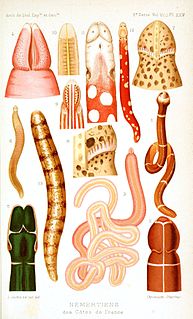
Nemertea is a phylum of invertebrate animals also known as ribbon worms or proboscis worms. Alternative names for the phylum have included Nemertini, Nemertinea and Rhynchocoela. Most are very slim, usually only a few millimeters wide, although a few have relatively short but wide bodies. Many have patterns of yellow, orange, red and green coloration. The foregut, stomach and intestine run a little below the midline of the body, the anus is at the tip of the tail, and the mouth is under the front. A little above the gut is the rhynchocoel, a cavity which mostly runs above the midline and ends a little short of the rear of the body. All species have a proboscis which lies in the rhynchocoel when inactive but everts to emerge just above the mouth and capture the animal's prey with venom. A highly extensible muscle in the back of the rhynchocoel pulls the proboscis in when an attack ends. A few species with stubby bodies filter feed and have suckers at the front and back ends, with which they attach to a host.
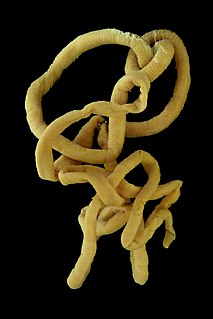
The bootlace worm is a species of ribbon worm and one of the longest known animals, with specimens up to 55 m (180 ft) long being reported, although this has not been confirmed. Its mucus is highly toxic.
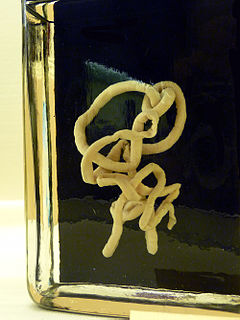
Anopla has long been used as name for a class of marine worms of the phylum Nemertea, characterized by the absence of stylets on the proboscis, the mouth being below or behind the brain, and by having separate openings for the mouth and proboscis. The other long used class of Nemertea are the Enopla. Although Anopla is a paraphyletic grouping, it is used in almost all Scientific classifications. Anopla is divided into two orders: Palaeonemertea and Heteronemertea.

Corophium is a genus of the amphipod family Corophiidae. Formerly a much larger genus, many species have been transferred to segregate genera such as Monocorophium and Crassicorophium.

Enopla is one of the classes of the worm phylum Nemertea, characterized by the presence of a peculiar armature of spines or plates in the proboscis.

Goneplax rhomboides is a species of crab. It is known by the common name angular crab because of its angular carapace. Although it is also called the square crab, its shell is in fact more trapezoidal than square. This species is also known as the mud-runner because they are able to run away quickly when threatened.

Parborlasia corrugatus is a proboscis worm in the family Cerebratulidae. This species of proboscis or ribbon worm can grow to 2 metres in length, and lives in marine environments down to 3,590 metres (11,780 ft). This scavenger and predator is widely distributed in cold southern oceans.
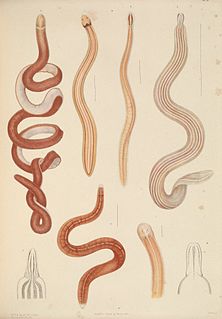
Emplectonema neesii is a species of ribbon worm in the phylum Nemertea. It is found on the middle and lower regions of the shore, under stones and in shingle and is common round the coasts of Britain and Ireland.

Phyllodoce maculata is a species of Polychaete worm in the family Phyllodocidae. It is native to the northeastern Atlantic Ocean where it inhabits shallow water areas of sand, mud and stones.

Polydora ciliata is a species of annelid worm in the family Spionidae, commonly known as a bristleworm. It is a burrowing worm and is found in the northeastern Atlantic Ocean and some other parts of the world.

Tubulanus polymorphus is a species of ribbon worm in the phylum Nemertea. It is found in the northern Atlantic Ocean and the northern Pacific Ocean. It occurs on the lower shore down to about 50 m (160 ft), on sand or gravel, under stones and among seaweed.

Tubulanus superbus, commonly known as the football jersey worm, is a species of ribbon worm in the phylum Nemertea. Found in the northern Atlantic Ocean, the North Sea and the Mediterranean Sea, it occurs from the lower shore down to about 80 m (260 ft), on sand or gravel.

Tubulanus annulatus, commonly known as the football jersey worm, is a species of ribbon worm in the phylum Nemertea. It ranges across the northern Atlantic Ocean, the North Sea and the Mediterranean Sea, being present from the lower shore down to about 40 m (130 ft), on sand, gravel and other habitats.

Cerebratulus lacteus, the milky nemertean or milky ribbon worm, is a proboscis worm in the family Lineidae. This ribbon worm has a wide geographical range on both sides of the northern Atlantic Ocean.
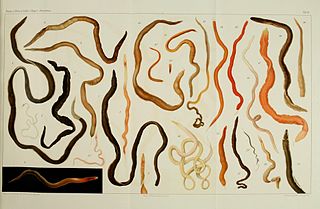
Cerebratulus marginatus is a proboscis worm in the family Lineidae. This ribbon worm has an Arctic distribution, and in the North Atlantic Ocean ranges as far south as Cape Cod and the Mediterranean Sea while in the Pacific Ocean it extends southwards to California.

Neanthes fucata is a species of marine polychaete worm in the family Nereididae. It lives in association with a hermit crab such as Pagurus bernhardus. It occurs in the northeastern Atlantic Ocean, the North Sea and the Mediterranean Sea.
Phascolosoma granulatum is a species of peanut worm in the family Phascolosomatidae. It is found in shallow water in the northeastern Atlantic Ocean and the Mediterranean Sea.

Aspidosiphon muelleri is a species of unsegmented benthic marine worm in the phylum Sipuncula, the peanut worms. This worm is found in the eastern Atlantic Ocean, the Mediterranean Sea and in various locations in the Indo-Pacific region at depths down to about 1,000 m (3,300 ft).

Echiurus echiurus is a species of spoon worm in the family Echiuridae. It is found in the North Atlantic Ocean and a subspecies is found in Alaska. It burrows into soft sediment and under boulders and stones in muddy places.
Maxmuelleria lankesteri is a species of spoon worm in the family Bonelliidae. It is found in the North Atlantic Ocean. It burrows into soft sediment on the seabed, mostly in deep water.

















